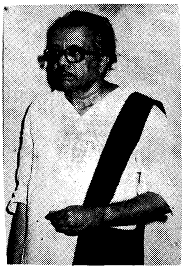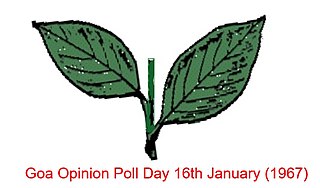Related Research Articles

Marathi is an Indo-Aryan language predominantly spoken by Marathi people in the Indian state of Maharashtra. It is the official language of Maharashtra, and a co-official language in Goa state and the territory of Damaon, Diu & Silvassa. It is one of the 22 scheduled languages of India, with more than 90 million speakers. Marathi ranks 10th in the list of languages with most native speakers in the world. Marathi has the third largest number of native speakers in India, after Hindi and Bengali. The language has some of the oldest literature of all modern Indian languages. The major dialects of Marathi are Standard Marathi, kokni, khandeshi and the Varhadi dialect.

The Indo-Aryan languages are a branch of the Indo-Iranian languages in the Indo-European language family that are spoken natively by the Indo-Aryan peoples. As of the early 21st century, they have more than 800 million speakers, primarily concentrated in India, Pakistan, Bangladesh, Nepal, Sri Lanka, and Maldives. Moreover, apart from the Indian subcontinent, large immigrant and expatriate Indo-Aryan–speaking communities live in Northwestern Europe, Western Asia, North America, the Caribbean, Southeast Africa, Polynesia and Australia, along with several million speakers of Romani languages primarily concentrated in Southeastern Europe. There are over 200 known Indo-Aryan languages.

Languages spoken in India belong to several language families, the major ones being the Indo-European languages spoken by 78.05% of Indians and the Dravidian languages spoken by 19.64% of Indians, both families together are sometimes known as Indic languages. Languages spoken by the remaining 2.31% of the population belong to the Austroasiatic, Sino–Tibetan, Tai–Kadai and a few other minor language families and isolates. India has the world's fourth highest number of languages (447), after Papua New Guinea (840), Indonesia (710), and Nigeria (524).
Bombay Hindi, also known as Bambaiya Hindi or Mumbaiya Hindi, is the Hindi dialect spoken in Mumbai (Bombay), in the Konkan region of India. Its vocabulary is largely from Hindustani, additionally, it has the predominant substratum of Marathi-Konkani, which is the official language and is also widely spoken in the Konkan division of Maharashtra. Bombay Hindi also has elements of Gujarati.

Konkani is an Indo-Aryan language spoken by the Konkani people, primarily along the western coastal region (Konkan) of India. It is one of the 22 scheduled languages mentioned in the 8th schedule of the Indian Constitution and the official language of the Indian state of Goa. It is a minority language in Karnataka, Maharashtra, Kerala, Gujarat and Dadra and Nagar Haveli and Daman and Diu.
Maharashtri or Maharashtri Prakrit, is a Prakrit language of ancient as well as medieval India and the ancestor of Marathi and Konkani.
The voiced retroflex lateral flap is a type of consonantal sound, used in some spoken languages. The expected symbol in the International Phonetic Alphabet is ⟨𝼈 ⟩. The sound may also be transcribed as a short ⟨ɭ̆ ⟩, or with the old dot diacritic, ⟨ɺ̣⟩.
Malvani is a dialect of Konkani with significant Marathi influences and loanwords. Although Malvani does not have a unique script, the Devanagari script is used by most speakers. Malvani is sometimes used for sarcastic newspaper articles and local folk stage dramas known as Dashavatar.

Konkani Muslims are an ethnoreligious subgroup of the Konkani people of the Konkan region along the west coast of India, who practice Islam. Nawayath Muslims from the North Canara district of Karnataka have similar origin as Konkani Muslims, but show a distinct ethnolinguistic identity due to geographical isolation of the Canara coast from the Konkan coast.
Narayan Govind Kalelkar was a linguist from Maharashtra, India.
The Marathi-Konkani languages are the mainland Southern Indic languages, spoken in Maharashtra and the Konkan region of India.

Ravindra Kelekar was a noted Indian author who wrote primarily in the Konkani language, though he also wrote in Marathi and Hindi. A Gandhian activist, freedom fighter and a pioneer in the modern Konkani movement, he is a well known Konkani scholar, linguist, and creative thinker. Kelkar was a participant in the Indian freedom movement, Goa's liberation movement, and later the campaign against the merger of the newly formed Goa with Maharashtra. He played a key role in the founding of the Konkani Bhasha Mandal, which lead the literary campaign for the recognition of Konkani as a full-fledged language, and its reinstatement as the state language of Goa. He authored nearly 100 books in the Konkani language, including Amchi Bhas Konkaneech, Shalent Konkani Kityak, Bahu-bhashik Bharatant Bhashenche Samajshastra and Himalayant, and also edited Jaag magazine for more than two decades.

The 1967 Goa status referendum popularly known as the Goa Opinion Poll was a referendum held in newly annexed union territory of Goa and Damaon in India, on 16 January 1967, to deal with the Konkani language agitation and to decide the future of Goa.

Kudaldeshkar Gaud Brahmin is a community hailing from the western coast of India, residing in the Konkan division of Maharashtra and Goa. This community is also known as Kudaldeshkar Aadya Gaud Brahmin, Kudaldeshkar and sometimes Kudalkar Brahmins. They speak Marathi, Malwani dialect of Konkani.
Sumitra Mangesh Katre, a lexicographer, Indo Aryan and Paninian linguist, was born at Honnavar, Karnataka and died in San Jose, California, USA. Katre initiated the gigantic Sanskrit Dictionary Project, An Encyclopedic Dictionary of Sanskrit on Historical Principles, with its 11 million slips preserved in the scriptorium.

Canarese Konkani are a set of dialects spoken by minority Konkani people of the Canara sub-region of Karnataka, and also in Kassergode of Kerala that was part of South Canara. Kanarese script is the primary mode of writing used in Carnatacan Konkani, as recognised by the Konkani Academy.
The Konkani language agitations were a series of protests and demonstrations in India, concerning the uncertain future and the official status of the Konkani language. They were held by Goans in the then union territory of Goa, Daman and Diu governed at the time by the Maharashtrawadi Gomantak Party. The protests involved citizen journalism, student activism and political demonstrations.
José Gerson da Cunha was a Goan physician who achieved international renown as an orientalist, historian, linguist and numismatist.

Maharashtri Konkani or Konkan Marathi, is a group of Konkanic dialects spoken in the Konkan division of the Konkan region. George Abraham Grierson, a British Indian linguist of the colonial era referred to these dialects as the Konkan Standard of Marathi in order to differentiate it inside the Konkani language group.
Balabodh is a slightly modified style of the Devanagari script used to write the Marathi language and the Korku language. What sets balabodha apart from the Devanagari script used for other languages is the more frequent and regular use of both ळ /ɭ/ and र्. Additionally, Balbodh style has ऍ/ॲ and ऑ as adaptations to pronounce [æ] and [ɒ] in English-based words. Another distinctive feature is the use of Anusvara over trailing अ, denoting lenghthening of the trailing vowel.
References
- ↑ Rahman, Tariq (2004). Language and education: selected documents, 1780-2003. Quaid-i-Azam University. p. 461. ISBN 9789698329082.
- ↑ Bright, William (1992). International encyclopedia of linguistics . Oxford University Press. p. 53. ISBN 9780195051964.
- ↑ Indian Linguistics. Linguistic Society of India. 30 (2): 76. 1969. ISSN 0378-0759.
{{cite journal}}: Missing or empty|title=(help) - ↑ "Konkani".